Benedict Joseph Fenwick | |
|---|---|
| Bishop of Boston | |
 | |
| See | Boston |
| Appointed | May 10, 1825 |
| Installed | December 21, 1825 |
| Term ended | August 11, 1846 |
| Predecessor | Jean-Louis Lefebvre de Cheverus |
| Successor | John Bernard Fitzpatrick |
| Orders | |
| Ordination | March 12, 1808 by Leonard Neale |
| Consecration | November 1, 1825 by Ambrose Maréchal |
| Personal details | |
| Born | September 3, 1782 Leonardtown, Maryland, U.S. |
| Died | August 11, 1846 (aged 63) Boston, Massachusetts, U.S. |
| Buried | College of the Holy Cross Cemetery |
| Denomination | Catholic Church |
| Alma mater | |
| Signature | |
Benedict Joseph Fenwick SJ (September 3, 1782 – August 11, 1846) was an American Catholic prelate, Jesuit, and educator who served as the Bishop of Boston from 1825 until his death in 1846. In 1843, he founded the College of the Holy Cross in Worcester, Massachusetts. Prior to that, he was twice the president of Georgetown College and established several educational institutions in New York City and Boston.
Born in Maryland, Fenwick entered the Society of Jesus and began his ministry in New York City in 1809 as the co-pastor of St. Peter's Church. He then became pastor of the original St. Patrick's Cathedral and later the vicar general and diocesan administrator of the Diocese of New York. In 1817, Fenwick became the president of Georgetown College, remaining just several months before he was tasked with resolving a longstanding schism at St. Mary's Church in Charleston, South Carolina. He remained in the city as vicar general for the Archdiocese of Baltimore until 1822, when he returned to Georgetown as acting president.
Fenwick became the Bishop of Boston in 1825, during a period of rapid growth of the city's Catholic population due to massive Irish immigration. At the same time, Catholics faced intense nativism and anti-Catholicism, culminating in the burning of the Ursuline Convent in 1834, threats against Fenwick's life, and the formation of the Montgomery Guards. Fenwick also addressed parochial conflict, ultimately placing a Boston church under interdict. He established churches, schools, charitable institutions, and newspapers throughout the diocese, which encompassed all of New England. Among these were The Pilot newspaper and the College of the Holy Cross.
Early life
Benedict Joseph Fenwick was born on September 3, 1782, at Beaverdam Manor in Leonardtown, Maryland,[1] to George Fenwick II, a planter and surveyor, and Margaret Fenwick, née Medley.[2] His paternal ancestors hailed from Northumberland in North East England. Benedict's great-great-great-grandfather, Cuthbert Fenwick, emigrated to America in the 1633 expedition of the Ark and the Dove, and was one of the original Catholic settlers of the British Province of Maryland.[3] Benedict's elder brother was Enoch Fenwick, who would also become a prominent Jesuit,[4] and his cousin was Edward Fenwick, who would become a Dominican and Bishop of Cincinnati.[5]
When Fenwick's family moved from Leonardtown to Georgetown in the District of Columbia, Fenwick was enrolled at Georgetown College in 1793.[2] Intending to enter the priesthood, he began his study of theology in 1801,[1] and proved to be a good student, earning highest academic honors. Upon completing his study of philosophy, he was made a professor at the college,[6] where he taught until 1805.[2]
That year, Fenwick entered St. Mary's Seminary in Baltimore, but remained for only a year,[1] before the Society of Jesus, which had been suppressed by the pope, was restored in the United States.[7] Therefore, he and his brother became among the first six to enter the newly restored Jesuit novitiate on October 10, 1806.[1][7] On March 12, 1808, Fenwick was ordained a priest at Georgetown College by Leonard Neale, the coadjutor bishop of the Archdiocese of Baltimore.[7]
Ministry in New York
In November 1808,[8] Fenwick was sent with Anthony Kohlmann to minister to the Catholics of New York City, where they were put in charge of St. Peter's Church, the only Catholic church in the city.[7] He assisted in establishing the New York Literary Institution, the second Jesuit school in New York City.[9] As an offshoot of Georgetown College, the institution was staffed by four Jesuit scholastics from Georgetown,[10] with Fenwick as president.[8] The school was opened in 1808, in a house on Mulberry Street,[10] across the street from the future site of the original St. Patrick's Cathedral.[11] It remained there only briefly, before relocating to Broadway in September 1809; it moved again in March 1810 to a plot of land "far out in the country,"[10] north of the New York City limits. This new site would eventually become the location of the new St. Patrick's Cathedral, in Midtown Manhattan.[9]

The school grew quickly, enrolling the sons of several prominent Catholic and Protestant families, and its curriculum emphasized the study of Latin, Ancient Greek, and French. However, the Jesuit superior in the United States, Giovanni Antonio Grassi, determined that there were not enough Jesuits in the United States to sustain both Georgetown and the New York Literary Institution.[9] Despite Kohlmann desiring to close Georgetown, Grassi sided with the bulk of Jesuits who were native to Maryland and ordered the New York school closed in 1813,[12] with it officially disbanding in April 1814.[9] Responsibility for the facility was transferred to the Trappist order.[11]
While in New York, Fenwick and Kohlmann were called for by the dying Thomas Paine, to his house in Greenwich Village.[13] Having been unsuccessfully treated by several physicians, Paine sought priests to heal him. They attempted to convince him to renounce a lifetime of writings denouncing Christianity, to which he angrily dismissed them from his house.[14]
Fenwick served alongside Kohlmann as pastor of Old St. Patrick's Cathedral from 1809 to 1815.[15] When Kohlmann was recalled to Maryland in 1815,[12] Fenwick replaced him as pastor of St. Peter's Church and as the diocesan administrator of the Diocese of New York.[16][17] He was successful in prompting hundreds of conversions to Catholicism throughout the diocese during his tenure.[18] Fenwick was present at the formal dedication of Old St. Patrick's Cathedral in 1816.[19] He also drew up designs for the new St. Patrick's Cathedral, the construction of which would be completed after he left New York.[18] The Dominican priest, Charles Ffrench, succeeded Fenwick as pastor of St. Peter's,[16] and John Power would eventually become the next pastor of Old St. Patrick's in 1825.[15] Fenwick became vicar general of the diocese for Bishop John Connelly in 1816,[18] replacing Kohlmann,[16] and remained at the post until April 1817.[8]
Georgetown College and South Carolina
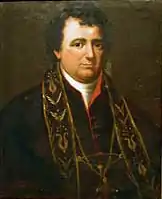
Fenwick became the president of Georgetown College and the pastor of Holy Trinity Church on June 28, 1817,[20] succeeding Grassi at the former,[21] and Francis Neale at the latter.[22] The college's first degrees were conferred during his brief term.[20] Later that year, Ambrose Maréchal, the Archbishop of Baltimore, sent Fenwick to Charleston, South Carolina, where there was a long-standing schism at a local Catholic church.[23] He was replaced at Georgetown by Anthony Kohlmann,[24] and at Holy Trinity by Theodore M. DeTheux.[22]
Fenwick arrived in Charleston in the fall of 1818 as vicar general of the Archdiocese of Baltimore for the city. His mission was to resolve the ecclesiastical dispute,[25] where the lay trustees at the predominantly Irish St. Mary's Church refused to accept a French priest as their pastor, and defied the orders of Archbishop Leonard Neale to have their desired pastor move to another parish.[26] With tensions long-standing, the French- and English-speaking parishioners refused to attend services said in the others' language. Fenwick resolved the dispute by preaching the sermons himself, in which he would alternate between French and English.[25] As vicar, he traveled throughout the Carolinas to minister. Fenwick remained in Charleston one year beyond the erection of the new Diocese of Charleston and the appointment of John England as the first bishop in 1820.[27]
In May 1822, Fenwick returned to Washington, D.C. as the minister of Georgetown College and the procurator of the Jesuits in the United States.[27] On September 15, 1825,[28] the Jesuit mission superior, Francis Dzierozynski, again made Fenwick acting president of the college and vice rector, as the incumbent president—his brother, Enoch—refused to return to the college after leaving for St. Thomas Manor.[29] His term as acting president lasted for just several months before he was replaced by Stephen Lariguadelle Dubuisson.[30] Fenwick then briefly became the spiritual director of the Mount Carmel Monastery in Port Tobacco, Maryland.[31]
Bishop of Boston
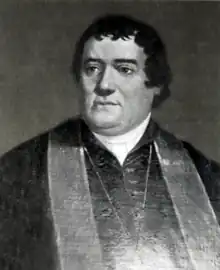
Fenwick was appointed the second Bishop of Boston by Pope Leo XII on May 10, 1825, succeeding Jean-Louis Lefebvre de Cheverus. The papal bull notifying him of his appointment arrived in July 1825, and he embarked on an eight-day spiritual retreat.[31] Upon its completion, Fenwick was consecrated a bishop in the Cathedral of the Assumption of the Blessed Virgin Mary in Baltimore on November 1.[32] Archbishop Ambrose Maréchal served as principal consecrator, while Bishops John England and Henry Conwell were co-consecrators.[31] Fenwick arrived in Boston on December 3, and formally took canonical possession of the Diocese of Boston at the original Cathedral of the Holy Cross, on December 21, 1825.[33]
Though the ecclesiastical jurisdiction of the diocese encompassed all of New England, Bishop Fenwick had only two priests under his charge, who served three Catholic churches, besides the cathedral, in all of New England: Saint Augustine's Chapel in Boston, St. Patrick's Church in Newcastle, Maine, and a small church in Claremont, New Hampshire.[34] Throughout New England, there were approximately 10,000 Catholics.[35] Due to significant Irish immigration, the Catholic population in the diocese grew to at least 30,000 by 1833.[36] Fenwick traveled throughout the large territory to manage the diocese and administer the sacrament of confirmation.[37] This included visiting Penobscot and Passamaquoddy tribes in Maine,[38] who were largely Catholic,[39] and were the subject of intensive proselytism by Protestant evangelists. Fenwick ordered the construction of St. Anne's Church in Old Town, Maine, for them in 1828,[40] and sought to improve their schools.[38]
Fenwick attended the First Provincial Council of Baltimore convened in 1829.[41] He addressed a shortage of priests in his diocese by sending prospective seminarians to Maryland and Canada to be educated, and by incardinating several priests from other dioceses.[36] He also trained several students in a makeshift seminary at his episcopal residence.[42] As a result, the number of priests in the diocese had increased to 24 by 1833.[36] At the same time, many new parishes were founded throughout New England.[43] As in South Carolina, Fenwick was an ardent opponent of lay trusteeism in the Diocese of Boston.[44] With a rapidly expanding Catholic population in the diocese, a portion of the territory was removed to form the Diocese of Hartford in 1843.[45] That year, John Bernard Fitzpatrick was appointed as Fenwick's coadjutor bishop,[46] and would later succeed him as Bishop of Boston.[47]
By the end of Fenwick's episcopate, the number of Catholics in the Diocese of Boston (after the removal of Hartford) had increased to 70,000, in addition to 37 priests, and 44 churches.[45] In December 1845, Fenwick's health began to decline, due to an ailment of the heart. Eight months later, he died on August 11, 1846,[48] at the Cathedral of the Holy Cross in Boston.[49] After the funeral, his body was carried from the Cathedral of the Holy Cross to the train station, from where it was taken to the College of the Holy Cross and buried in the school's cemetery.[50] Bishop Fenwick High School in Peabody, Massachusetts, which opened in 1959, was named in his honor.[51] The historic Benedict Fenwick School was a public school in Boston that operated from 1912 to 1981.[52]
Educational institutions
One of Fenwick's primary tasks was the creation of Catholic educational institutions in Boston. He established a Sunday school at the Cathedral of the Holy Cross, where Fenwick himself catechized both children and their parents. This was followed by the establishment of a co-educational day school.[53] The cathedral was eventually enlarged, which included the construction of two classrooms in the basement for use by these schools.[53] Fenwick also invited the Sisters of Charity from Emmitsburg, Maryland, to Boston to educate the immigrant children of the city in 1832.[54] Three sisters arrived on May 2, 1832, and founded the first Catholic charitable institution in Massachusetts, which consisted of an orphanage, a school for poor girls, and a Sunday school.[55] This institution would be incorporated in 1843 as St. Vincent's Orphan Asylum, and operated until 1949.[56]
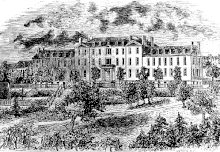
By 1830, the establishment of a Catholic college and seminary became Fenwick's highest priority. In April of the following year, he purchased land adjacent to the Boston cathedral, where he planned to open a college, but the project stalled. He desired to have the school run by the Jesuits, but in 1835, they declined his invitation, and his plan for a college was placed on hold.[57]
In the spirit of the ongoing Restoration Movement in the United States, Fenwick purchased 11,000 acres (4,500 hectares) in Aroostook County, Maine, in 1835. The compound became known as Benedicta, and on it, lumber and grist mills as well as agriculture were begun.[57] There, he sought to create a college in the wilderness, which would be part of a larger utopian Catholic community where Irish Catholics of Boston, who lived in squalor, could resettle. However, the Bostonians showed little interest in moving to Maine.[58]
Therefore, Fenwick instead decided to establish a college in Worcester, Massachusetts, on 60 acres (24 hectares) of land owned by the local priest, James Fitton. Fenwick purchased the land from Fitton in 1842, and named the new school the College of the Holy Cross, in honor of the original Boston cathedral.[59] This property was then supplemented, bringing its total to 96 acres (39 hectares), and in 1843, Fenwick entrusted the new college to a party of Jesuits sent from Georgetown College.[46] That year, construction of the college's first building began,[60] which would later become known as Fenwick Hall.[61]
Catholic media
Fenwick established several Catholic newspapers in the diocese. The first was The Catholic Press, which was founded in 1829 in Hartford, Connecticut, and survived for five years. Another was The Expostulator, which was established in 1830, and was written for young people; this publication survived for only two years. Fenwick's most enduring newspaper was The Jesuit, or Catholic Sentinel, which was founded in Boston in 1829. It later became known as The Pilot, which is today the oldest extant Catholic newspaper in the United States.[62]
He also assisted in editing the Catholic Laity's Directory, which was produced by John Power, the vicar general of New York, in 1822. Fenwick wrote a history of the Diocese of Boston from its founding to 1829, titled "Memoirs to Serve for the Future Ecclesiastical History of the Diocess of Boston," but this was never published during his lifetime. He also directed many historical Catholic books to be reprinted for the diocese.[62]
Anti-Catholicism in New England
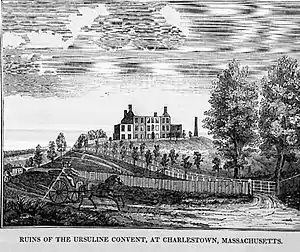
A convent of Ursuline nuns, which also conducted a free school for poor girls, was located next to the Boston cathedral.[63] As their facilities were inadequate, Fenwick purchased a new property for the nuns in Charlestown,[64] today located in East Somerville.[65] The purchase was made on July 17, 1826,[64] and the nuns erected a new convent and school there, completing their move in 1828.[63] They named it the Convent and Academy of Mount Benedict, in honor of the bishop.[64] As the nuns' vow of enclosure did not allow them to actively manage the construction of the new facilities, or their expansion in 1829, Fenwick oversaw much of the work.[63] With the change in location came a change in mission; the school began charging tuition, and though it admitted some students for free, it sought to primarily educate the daughters of the elite Protestant residents of Charlestown.[66]
Nativism and anti-Catholicism were rampant in Greater Boston at this time.[67] Lurid rumors that Catholic convents were dens of immorality were prevalent; among these were allegations that convents imprisoned women against their will, murdered babies, and concealed sexual deviance.[68] While upper-class Protestants were willing to send their daughters to the Catholic academy, lower-class Protestants, particularly Congregationalists, were distrustful of the school.[67] These tensions led to the Ursuline Convent riots. On August 10, 1834, posters were displayed in the neighborhood that declared an ultimatum: unless the convent were investigated by the board of selectmen of Charlestown, it would be "demolished" by the "Truckmen of Boston." The following day, authorities were sent to inspect the convent. As they left, a mob of 2,000, wearing masks or painted faces, encircled the convent. They threw bricks through the windows, stole precious objects from the interior, and then lit it ablaze; the nuns fled. The fire department, which largely shared the attitudes of the rioters, arrived but did not attempt to extinguish the fire. The convent's adjacent graveyard was attacked as well.[69] All but one of the perpetrators were acquitted in a subsequent jury trial.[70] The Massachusetts legislature refused to redress the destruction of the convent.[65]
Anti-Catholic sentiment in the city only increased after the convent riots, which caused the Ursuline nuns to flee to Canada.[71] Tensions steadily grew until some feared the outbreak of a religious war.[72] The Charlestown selectmen banned Catholics from being buried in the Catholic cemetery Fenwick established on Bunker Hill.[73] An effigy of Bishop Fenwick was shot with guns in 1835, and threats were made on his life. Widespread violence and destruction occurred during the Broad Street Riot of 1837, and Irish Catholics took up arms as the Montgomery Guards. Another burning of a Catholic church occurred in 1838 in Burlington, Vermont.[72]
Dispute at St. Mary's Church
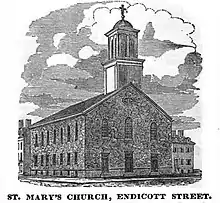
Fenwick's episcopate involved numerous conflicts both among parishioners over control of their respective churches, and between parishioners and the bishop. Some of these disputes turned violent, and involved calls for leaving the Catholic Church to create new churches.[74]
One such dispute arose at St. Mary's Church in the North End of Boston in 1840. That year, Patrick O'Beirne and Thomas J. O'Flaherty were appointed co-pastors of the predominantly Irish church. The parish quickly became polarized, with parishioners supporting either O'Flaherty, who advocated strong lay control of the church, or O'Beirne, who advocated episcopal control. Divisions were further deepened by O'Flaherty's support of the temperance movement and opposition to the Acts of Union 1800, which united Ireland and Great Britain. By 1842, the congregation was so divided that Fenwick worried violence might erupt. Therefore, he attempted to restore peace by personally visiting the church, threatening excommunication for disobedience of church authorities, banning mass protests,[75] and ordering the two pastors to publicly reconcile. Eventually, Fenwick transferred O'Beirne to Providence, Rhode Island, at O'Beirne's request.[76]
None of these efforts was effective in restoring tranquility, and on February 20, 1842, O'Beirne's supporters began a riot during a vespers service over which O'Flaherty presided. The perpetrators were arrested and prosecuted, and Fenwick placed the parish under interdict for two weeks. He then transferred O'Flaherty to Salem, Massachusetts, and removed O'Beirne from Providence. Though O'Flaherty's supporters demanded his return, and organized regular train rides to visit him, the dispute at St. Mary's came to an end.[76]
References
Citations
- 1 2 3 4 Lord 1936, p. 173
- 1 2 3 O'Connor 1998, p. 42
- ↑ Clarke 1872, p. 374
- ↑ Clarke 1872, p. 375
- ↑ O'Daniel 1920, p. 32
- ↑ Clarke 1872, p. 376
- 1 2 3 4 Clarke 1872, p. 377
- 1 2 3 Lord 1936, p. 174
- 1 2 3 4 Andreassi 2014, p. 18
- 1 2 3 McGucken 2008, p. 72
- 1 2 Clarke 1872, p. 378
- 1 2 McGucken 2008, p. 73
- ↑ Clarke 1872, p. 379
- ↑ Clarke 1872, pp. 383–384
- 1 2 The Catholic Church in the United States of America 1914, p. 304
- 1 2 3 The Catholic Church in the United States of America 1914, p. 366
- ↑ Clarke 1872, p. 385
- 1 2 3 Clarke 1872, p. 387
- ↑ The Catholic Church in the United States of America 1914, p. 303
- 1 2 Shea 1891, p. 51
- ↑ Shea 1891, p. 49
- 1 2 Gillespie, Kevin (December 6, 2015). "From the Pastor's Desk" (PDF). Holy Trinity Catholic Church Bulletin. Washington, D.C.: Holy Trinity Catholic Church. p. 2. Archived (PDF) from the original on December 16, 2018. Retrieved January 4, 2019.
- ↑ Shea 1891, p. 53
- ↑ Shea 1891, p. 54
- 1 2 Clarke 1872, p. 388
- ↑ Furey 1887, p. 185
- 1 2 Clarke 1872, p. 389
- ↑ Shea 1891, p. 62
- ↑ Curran 1993, p. 98
- ↑ Curran 1993, p. 404
- 1 2 3 Clarke 1872, p. 390
- ↑ Meehan 1907
- ↑ Clarke 1872, p. 391
- ↑ Clarke 1872, p. 394
- ↑ Lord 1936, p. 175
- 1 2 3 Lord 1936, p. 179
- ↑ Clarke 1872, pp. 397–398
- 1 2 Clarke 1872, p. 403
- ↑ Clarke 1872, p. 398
- ↑ O'Connor 1998, pp. 47–48
- ↑ Clarke 1872, p. 404
- ↑ O'Connor 1998, p. 45
- ↑ Lord 1936, pp. 179–180
- ↑ Patkus 2001, p. 64
- 1 2 Lord 1936, p. 182
- 1 2 Clarke 1872, p. 407
- ↑ Patkus 2001, p. 71
- ↑ Lord 1936, p. 183
- ↑ Hurst, Violet (August 13, 2021). "August marks 175th anniversary of Bishop Fenwick's death". The Pilot. Archived from the original on November 7, 2021. Retrieved November 7, 2021.
- ↑ O'Connor 1998, p. 75
- ↑ "Mission & History". Bishop Fenwick High School. Archived from the original on June 10, 2020. Retrieved June 10, 2020.
- ↑ National Register of Historic Places Registration Form: Benedict Fenwick School 2004, section 8, pp. 5, 8
- 1 2 Clarke 1872, p. 395
- ↑ O'Connor 1998, p. 48
- ↑ Lester, Thomas (March 16, 2018). "Massachusetts' First Catholic Charitable Institution". The Pilot. Archived from the original on June 9, 2020. Retrieved June 9, 2020.
- ↑ O'Connor 1998, p. 49
- 1 2 Kuzniewski 1999, p. 20
- ↑ O'Connor 1998, pp. 72–73
- ↑ O'Connor 1998, p. 74
- ↑ Kuzniewski 1999, p. 29
- ↑ "Holy Cross: 1843–1899". College of the Holy Cross. Archived from the original on December 2, 2018. Retrieved December 2, 2018.
- 1 2 Lord 1936, p. 177
- 1 2 3 Hamilton 1996, p. 39
- 1 2 3 Clarke 1872, p. 396
- 1 2 Lord 1936, p. 180
- ↑ Hamilton 1996, p. 40
- 1 2 Hamilton 1996, p. 42
- ↑ Tager 2001, p. 109
- ↑ Tager 2001, p. 113
- ↑ Tager 2001, p. 117
- ↑ Lord 1936, pp. 180–181
- 1 2 Lord 1936, p. 181
- ↑ Kuzniewski 1999, p. 18
- ↑ Patkus 2001, p. 69
- ↑ Patkus 2001, p. 67
- 1 2 Patkus 2001, p. 68
Sources
- Andreassi, Anthony D. (2014). Teach Me to Be Generous: The First Century of Regis High School in New York City. New York: Fordham University Press. ISBN 9780823256334. Archived from the original on June 1, 2020. Retrieved June 1, 2020 – via Google Books.
- Clarke, Richard H. (1872). "Rt. Rev. Benedict Joseph Fenwick, D.D.". Lives of the Deceased Bishops of the Catholic Church in the United States. Vol. 1. New York: P. O'Shea. pp. 374–413. OCLC 809578529. Retrieved May 28, 2020 – via Internet Archive.
- Curran, Robert Emmett (1993). The Bicentennial History of Georgetown University: From Academy to University, 1789–1889. Vol. 1. Washington, D.C.: Georgetown University Press. ISBN 978-0-87840-485-8. Archived from the original on June 10, 2020. Retrieved June 10, 2020 – via Google Books.
- Furey, Francis T. (October 1887). "The Charleston, S. C., Schism of 1815–1818". The American Catholic Historical Researches. 4 (2): 184–188. JSTOR 45213255.
- Hamilton, Jeanne (Winter 1996). "The Nunnery as Menace: The Burning of the Charlestown Convent, 1834". U.S. Catholic Historian. 14 (1): 35–65. JSTOR 25154540.
- Kuzniewski, Anthony J. (1999). Thy Honored Name: A History of the College of the Holy Cross, 1843–1994. Washington, D.C.: Catholic University of America Press. ISBN 978-0-81320-911-1. Archived from the original on June 10, 2020. Retrieved June 9, 2020 – via Google Books.
- Lord, Robert H. (July 1936). "The Organizer of the Church in New England: Bishop Benedict Joseph Fenwick (1782–1846)". The Catholic Historical Review. 22 (2): 172–184. JSTOR 25013478.
- McGucken, William J. (2008) [1st pub. 1932]. The Jesuits and Education. Eugene, Oregon: Wipf & Stock. ISBN 978-1-60608-183-9. Archived from the original on June 1, 2020. Retrieved June 1, 2020 – via Google Books.
- Meehan, Thomas Francis (1907). "Archdiocese of Boston". In Herbermann, Charles (ed.). Catholic Encyclopedia. Vol. 2. New York: Robert Appleton Company. OCLC 1017058.
- "National Register of Historic Places Registration Form: Benedict Fenwick School" (PDF). National Archives and Records Administration. National Park Service. February 11, 2004. Archived (PDF) from the original on November 14, 2021. Retrieved November 14, 2021.
- O'Connor, Thomas H. (1998). Boston Catholics: A History of the Church and Its People. Boston: Northeastern University Press. ISBN 1-55553-359-0 – via Internet Archive.
- O'Daniel, V. F. (1920). The Right Rev. Edward Dominic Fenwick O.P.: Founder of the Dominicans in the United States. Washington, D.C.: The Dominicana. OCLC 918450662. Retrieved January 20, 2021 – via Internet Archive.
- Patkus, Ronald D. (Winter 2001). "Conflict in the Church and the City: The Problem of Catholic Parish Government in Boston" (PDF). Historical Journal of Massachusetts. 29 (1): 53–76. Archived (PDF) from the original on June 10, 2020. Retrieved June 10, 2020.
- Shea, John Gilmary (1891). Memorial of the First Century of Georgetown College, D.C.: Comprising a History of Georgetown University. Vol. 3. Washington, D.C.: P. F. Collier. pp. 50–53. OCLC 960066298. Archived from the original on June 1, 2020 – via Google Books.
- Tager, Jack (2001). Boston Riots: Three Centuries of Social Violence. Boston: Northeastern University Press. ISBN 1-55553-461-9. Retrieved November 13, 2021 – via Internet Archive.
- The Catholic Church in the United States of America: Undertaken to Celebrate the Golden Jubilee of His Holiness, Pope Pius X. Vol. 3. New York: Catholic Editing Company. 1914. OCLC 972339830. Retrieved June 1, 2020 – via Internet Archive.
Further reading
- Brownson, Orestes A. (1884) [Originally published 1846]. "Bishop Fenwick". In Brownson, Henry F. (ed.). The Works of Orestes A. Brownson. Vol. 14. Detroit: Thorndike Nourse. pp. 470–485. OCLC 633322512 – via Google Books.
- Sr. Marie of the Visitation Nicknair, O.P. (June 1962). Bishop Benedict J. Fenwick and the Origins of the Benedicta, Maine Community (PDF) (Master of Arts thesis). Boston College. Archived (PDF) from the original on July 7, 2019. Retrieved May 28, 2021.
External links
- "Bishop Benedict Joseph Fenwick, S.J." Catholic-Hierarchy.org. David M. Cheney.
